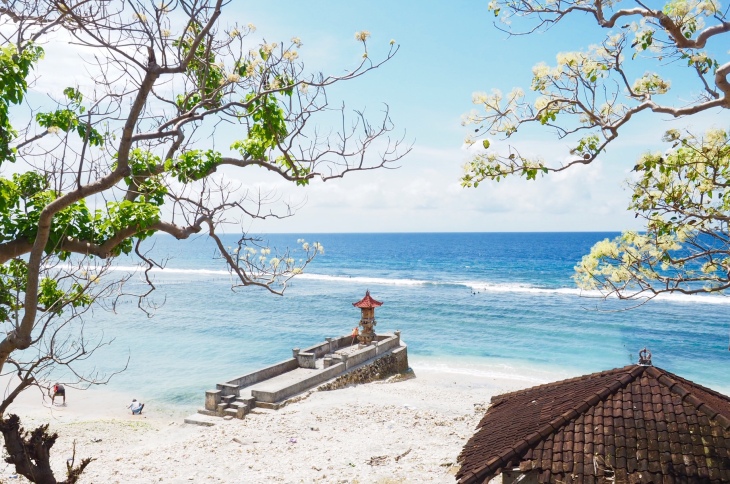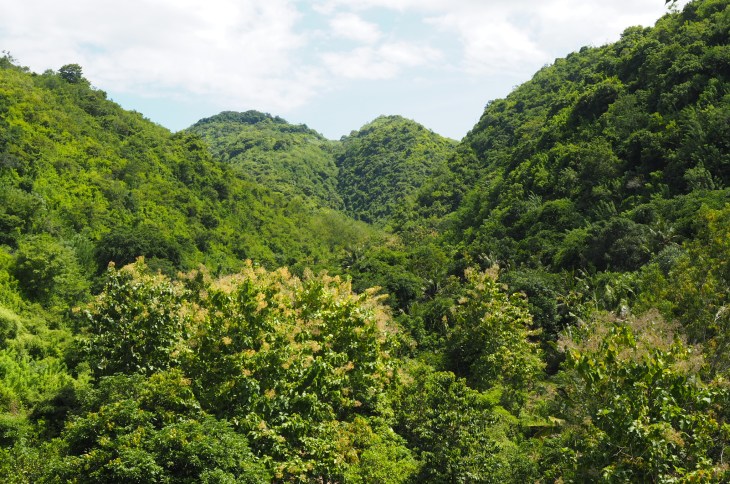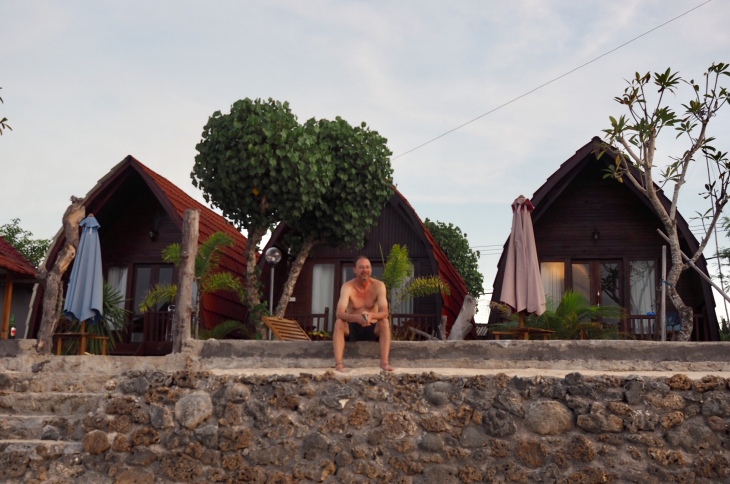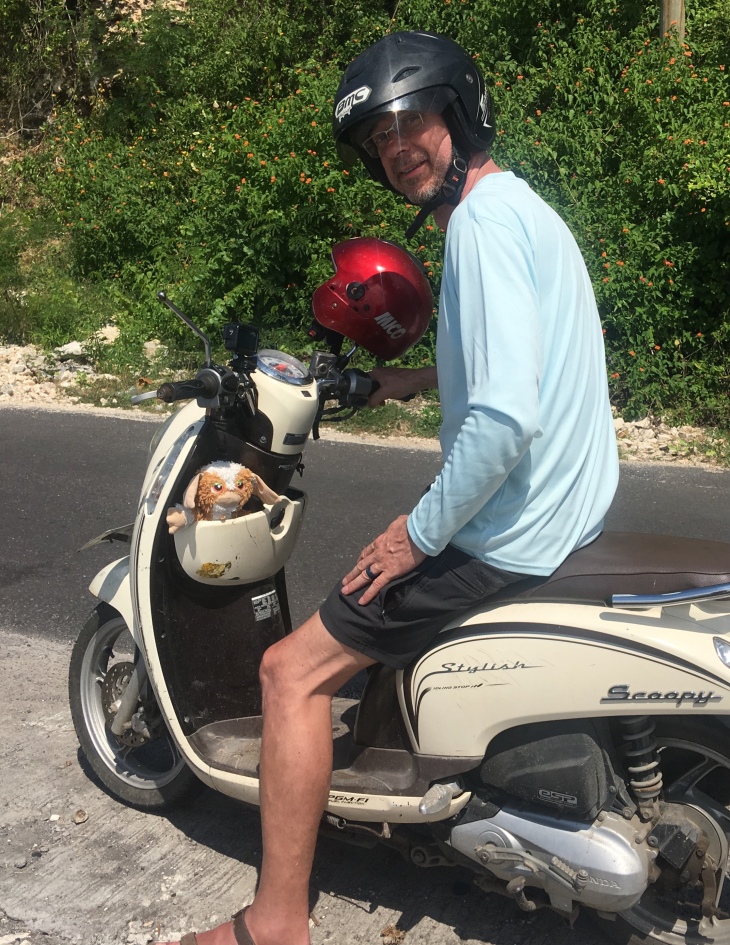Rob: The food here in Indonesia represents many of our favorite world tastes. We constantly crave this little group and are always looking out for the best local preparations of each.

An extraordinary amount of green chiles being chopped for sambal and other Indonesian treats.
Sambal is the chili based condiment that can range from spicy to super spicy. It is usually ground in a mortar with chilis, shallots, ginger, salt and a little fish sauce as the base and then varies by the village or family recipe of the maker. As a non-local we often have to ask for it as it can be too much spice for casual tourists, but when we and other travelers speak Bahasa and look a little rough and dirty from backpacking or the motorbike, we get the good stuff right away.

Suckling pig, or babi, on display at the Babi Guling warung (restaurant).

The Babi Guling special
Babi Guling is roast suckling pig and it is to-die-for here. Babi Nasi will be the way it is served in tourist restaurants which has a generous serving of sweet roasted meat and rice. Really is it best served mixed or Campur (chomp-pour) style in a local warung. When you ask for Babi Campur with Nasi & Soto, you will get a banana leaf over a plate with rice, a small portion of sliced sweet meat, shredded meat mixed with green chilies, dried liver chips, blood sausage, offal sausage, lacquered skin, fried skin rinds and a Soto, bone broth soup. Wash it all down with a cold Bintang and look for a shady place to rest and rub your belly!

Goat sate cooking on the grill

This goat sate drenched in peanut sauce and accompanied by rice and soto was one of the most flavorful dishes we enjoyed during our entire trip in Indonesia this year.
Sate is common and found everywhere but some of our best finds have been when we spot a particular type of grill being used. They are shallow, long and narrow. Just wide enough to lay the sate sticks across and barely deep enough to hold the charcoal made from coconut husks. Kambing (Goat) may be our favorite since it is typically only found out in the countryside where goats are raised or near markets where they are sold / traded. Sapi is beef and not seen as often. Ayam (Chicken) is everywhere because chickens themselves are everywhere. I’m always dodging them with the motorbike hoping I don’t need to pay a family if I don’t thread the needle just right. We tell a lot of “Why did the Chicken cross the road?” jokes and Gizmo has a favorite song “Ayam Superman” channeled from Michael Stipes. Oh yeah, back to the sate. Chilis are ground with peanuts and oil to dip your sate in and you can make it a meal with Nasi and Soto if you like. Every now and then you find it served with rice steamed inside a woven banana leaf box or tube so it cooks under pressure and forms a starchy rich nutty herbal tasting base for your sate, peanut sauce and lots of local sambal.

Nasi Jingo comes wrapped in a banana leaf and secured by toothpick as shown here.

Nasi Jingo is a cheap and tasty delight.
Nasi Jingo is found on the Balinese islands and not to much afar from here in other areas. It is a cheap, quick snack bound up in a banana leaf and traditionally made for and eaten by workers at the beginning or end of their shift. Markets, ports and major intersections are where little temporary stands pop up in the mornings and evenings. 90% rice and 10% simple but savory additions from the area. If you are near a port or fishing village it is usually spicy shredded Ikan (Fish), sometimes with salty sun dried sardines. Near a market? Sapi, Ayam or Babi shredded with cabbage and other veggies. Always with good sambal to bring those tears of spice and joy to our faces.

Masakan Padang is displayed in a case where you choose what you would like to load your plate with.
Our eye will usually catch a sign for Masakan Padang when we see it flash by on the bike. This is a whole style of food from the West Coast of Sumatra, but known all over Indonesia. It is based on coconut milk curry. The Warungs display many dishes in an artistic window stacked like a tiered house of cards or a carnival game. Several different preparations of fish, chicken and beef usually are at the top. Then egg “omelette” and different vegetables and fritters on the middle layer. In a steam table base layer there will be beautiful steamed jasmine rice, curry sauces from mild to wild, steamed greens and various sambals or just a straight chopped chili shallot mix to add to your plate. You call out what you like, point if you don’t know the name and let the chef guide you through the fresh favorites. So effing good that we always seem to over eat when we find a great place to sit for a full Masakan Padang meal.

Enjoying breakfast of champions, Bakso

A non-mobile Bakso cart. The balls stacked up are the infamous Bakso balls.

Bakso is often served directly off the back of a motorbike, as many Indonesian dishes are. We absolutely love these warungs on wheels.
Bakso is another one of our faves that you will see everywhere in Indonesia. It mainly comes from small carts along the popular roadside areas but you will also see plenty of mobil Bakso motorcycles as well. I’ve even seen a Bakso sidecar that I thought was pretty cool. The best Bakso Ayam is a rich chicken broth with a couple types of noodles floating in it. The Ayam part is chicken meat balls. I use the word meat a little loosely because anything that is not a beak or feet can be made into a paste, formed into a light fluffy ball and poached in the broth. Most are a mix of cartilage, skin and meat whipped into light fluffy meatballs that have a concentrated chicken taste. Add hard boiled egg if you like, a pinch of fresh herbs, maybe fried chicken skin or fried flat noodles on top then as much sambal as you dare. Savory spicy chicken goodness for usually about a dollar a serving. Lacy and I can always tell when the other person reached the bottom of their bowl by the pleasure and pain look on their face. You see, the chili seeds sink to the bottom of the dish and the last two slurps you drink directly from the bowl are the fire that burns so very good.
One item that we weren’t able to secure this last trip is my favorite flavor of pure Indonesian firewater. Arak is the moonshine here. It can range from about 80 proof up to nearly pure alcohol. In fact last year a lady selling it to me proudly poured a capful on the counter and lit it on fire to show its potency. On Bali and it’s neighboring islands, you really have to be a local to buy it. We have been in much more remote areas where it was proudly displayed on the countertop at the all the local bodegas. There is a cloudy variety which is low quality and about $1 for a small plastic water bottle and up to $2.50 for the clear high octane version which we always bought hoping it was good enough to not make us go blind. But in areas like we have been so far, the word has obviously spread. DON’T sell to tourists. I had one conversation with a older lady running a little family bodega where I just knew she had it hidden. I used my best Bahasa and asked for “satu Arak kecil”, a “small bottle of Arak.” I had my 20,000 rupee bill already out and extended to her. She stared at me for about the full breath I was holding and then shook her head. I said as politely as I could “bagus?” or “good?” with a little confident please in my voice. She stared again for about twice as long and then simply turned around and walked away from her little store and back to sweeping as she was when I pulled up. Thwarted again. The owner of the Homestay asked us when we got home later if we were able to get what we wanted. My reply almost made him fall over laughing from the ladder he was on when I said that they just won’t sell to a Bule (white foreigner).

Good times at Penida Colada

This visit to Nusa Penida has us also enamored with a beach bar cheekily named Penida Colada. We had stopped into a few other beach bars and found them to be nice spots to take a photo, but not always the best drinks or value and full of day-tripping tourists. Penida Colada was a little away from the main hotels and port on a little dead end alley road that ran along the beach. This was not on the Instagram tour. But it was clean comfortable and had beach chairs, beach bean bags, floor seating and lounge tables mixed into dining tables under several low thatch roofed pagodas tightly knit together with a solo guitarist in the corner. The sunset mixed with candle light, giggling girls, boisterous surfer boys and kissing couples created a perfect atmosphere. Drinks. Yes. The drinks were what I wanted to write about. Lacy and I are big fans of craft cocktails from Prohibition to Tiki style. The cocktails at Penida Colada were twists on classics with local additions that truly elevated each drink. Hibiscus flowers were macerated into a Planters Punch to give it a beautiful aroma to go along with the tropical flavors. Lemongrass was muddled into a Mojito and became even more refreshing. Purple Dragonfruit was blended with lime and rum into an amazing rich tasting Daiquiri. Honestly I have a really hard time choosing between a non-alcohol dragonfruit smoothie that is made with sweetened condensed milk or the rum Daiquiri version. Then there is my new favorite twisted blender drink of all time! A Pina Colada but not just any old overly sweet coconut rum and pineapple frozen drink. This one uses fresh unsweet coconut milk from a coconut that likely fell on the roof of the place, small super sweet pineapples from across the street, rum and the secret ingredient, Pandan Juice. Not the fruit of the Pandan tree but the sticky green syrupy extract from the thin palm like leaves. First it makes the Colada a beautiful light pale green color. Best if all, it is a perfect twist and compliment to your standard Colada by adding a honey fructose herbal taste that I’ve never had before. Winner all the way around. Happy Hour here means that you can get 2 tall frozen ones for 80,000 Rupees or about $2.57 each. Satu Lagi (one more)!

Sate Babi, Lontong rice and Bintang on black sand beaches. A little piece of heaven.
Side note. No. We don’t get paid for the blog for anywhere we endorse or encourage you to visit. We just want you to go!! But… If anyone has a contact in the Bintang Beer Marketing Department, we might consider them because it would surely offset our Beer and Radler bill a little. 🙂
Teaser alert…

We just spent our first two days in India devouring the street food in New Delhi. More to come very soon!








 As we traveled to the temple off the beaten path we waved to all the kids on the street, returned high fives, dodged a few chickens and eventually arrived Besakih Temple. We were both craving a bit more cultural knowledge to fill in some gaps and we paired up with Ketut, a volunteer, at the temple entrance. He spoke English and made our visit to this holy place something we will always hold dear. Ketut explained that we were visiting on a special day and that evening would commence the New Moon ceremony when families would flock to the temple to pray. Before entering the temple we purchased offerings and Ketut said that he would take us to the very top of the temple, 1,000 meters above sea level, where we could pray and mediate together. Nearly 1,300 years old, the oldest on the entire island, the temple is a magnificent piece of architecture. As we climbed the steps to the top Rob and I asked many questions and Ketut explained the meaning behind the different colors of umbrellas (representing the natural elements of wind, water and fire), the black and white checkered cloth used to wrap holy trees and statues (symbolizing yin and yang), why temples have different heights (family and villages temples vs those that are larger) and so much more. We were trying to learn as much as possible. At the very top we removed our shoes and Ketut lead us through the traditional prayer ceremony using the flowers and incense we had. We meditated shortly before winding our way back down the steps, taking a few photos and showing our gratitude to Ketut.
As we traveled to the temple off the beaten path we waved to all the kids on the street, returned high fives, dodged a few chickens and eventually arrived Besakih Temple. We were both craving a bit more cultural knowledge to fill in some gaps and we paired up with Ketut, a volunteer, at the temple entrance. He spoke English and made our visit to this holy place something we will always hold dear. Ketut explained that we were visiting on a special day and that evening would commence the New Moon ceremony when families would flock to the temple to pray. Before entering the temple we purchased offerings and Ketut said that he would take us to the very top of the temple, 1,000 meters above sea level, where we could pray and mediate together. Nearly 1,300 years old, the oldest on the entire island, the temple is a magnificent piece of architecture. As we climbed the steps to the top Rob and I asked many questions and Ketut explained the meaning behind the different colors of umbrellas (representing the natural elements of wind, water and fire), the black and white checkered cloth used to wrap holy trees and statues (symbolizing yin and yang), why temples have different heights (family and villages temples vs those that are larger) and so much more. We were trying to learn as much as possible. At the very top we removed our shoes and Ketut lead us through the traditional prayer ceremony using the flowers and incense we had. We meditated shortly before winding our way back down the steps, taking a few photos and showing our gratitude to Ketut.




























































 Lacy: After a full day on what we have affectionately begun to refer to as the “club foot” or “clubby” (due to the swelling caused by Rob’s healing broken leg) a relaxing day on Nusa Penida island was in order. Many tourists travel the short distance to this island on a one or two day excursion from Bali, see the highlights and leave. Rob and I prefer to travel differently, to take the time to really soak in a place and not rush through doing the “Chevy Chase” at each major location. Currently, with the limitations of club foot we are alternating days exploring with those spent face down on a massage table or lounging on the beach. Believe me, no one is complaining. After finishing our preferred breakfast of fruit and Balinese coffee seaside at our place we strolled through the sand to another beachfront location where even stronger coffee and dragonfruit smoothies were had.
Lacy: After a full day on what we have affectionately begun to refer to as the “club foot” or “clubby” (due to the swelling caused by Rob’s healing broken leg) a relaxing day on Nusa Penida island was in order. Many tourists travel the short distance to this island on a one or two day excursion from Bali, see the highlights and leave. Rob and I prefer to travel differently, to take the time to really soak in a place and not rush through doing the “Chevy Chase” at each major location. Currently, with the limitations of club foot we are alternating days exploring with those spent face down on a massage table or lounging on the beach. Believe me, no one is complaining. After finishing our preferred breakfast of fruit and Balinese coffee seaside at our place we strolled through the sand to another beachfront location where even stronger coffee and dragonfruit smoothies were had. 











 A five minute walk from the Billabong is Broken Beach which is a gorgeous scenic view, but not a place to swim since there is no access point. Looking down you see clear green and blue water lapping against a white sand beach. A natural land bridge with a hole in it allows the sea to access this strip of coast. Again, a very unique view. Nusa Penida island began receiving a greater number of tourists about 3 years ago and as of now the natural beauty seems to be intact. I desperately hope that the influx of people does not harm its natural treasures.
A five minute walk from the Billabong is Broken Beach which is a gorgeous scenic view, but not a place to swim since there is no access point. Looking down you see clear green and blue water lapping against a white sand beach. A natural land bridge with a hole in it allows the sea to access this strip of coast. Again, a very unique view. Nusa Penida island began receiving a greater number of tourists about 3 years ago and as of now the natural beauty seems to be intact. I desperately hope that the influx of people does not harm its natural treasures.





























